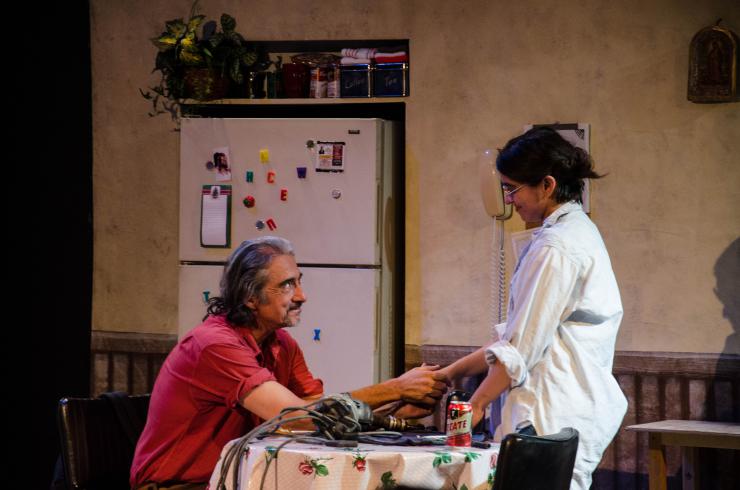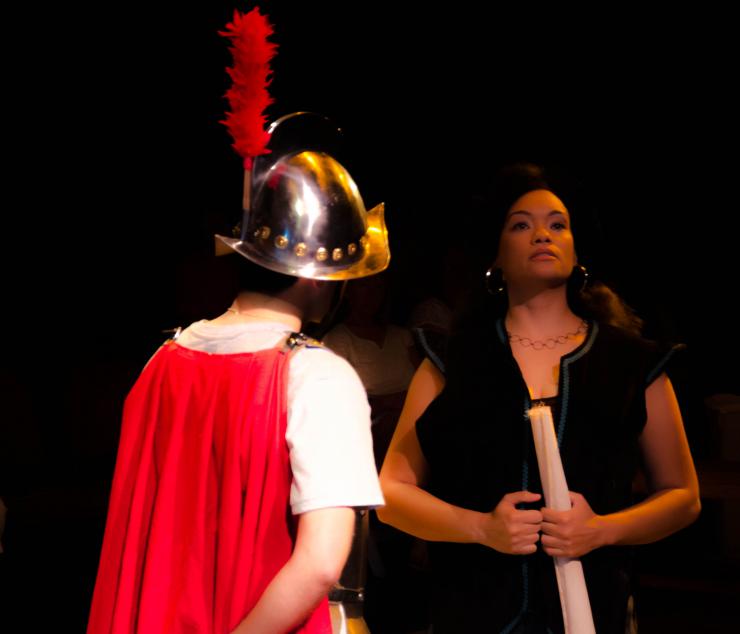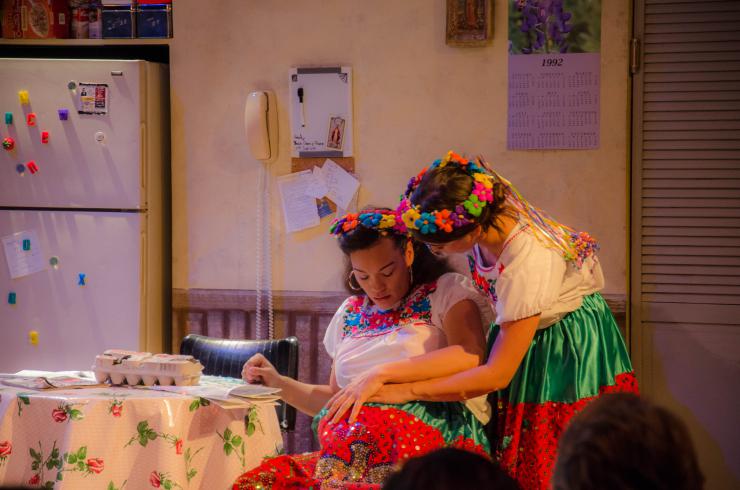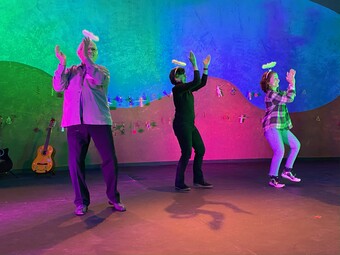A Huge Epic in a Small Package
The problem with drinking too much coffee is that, eventually, the tolerance for the caffeine becomes counter-intuitive. And at that ungodly hour, on my way to JFK airport, the slow effect of the coffee had me suddenly asking myself “Why am I doing this again?”
I was on my way to Santa Fe, New Mexico to catch the opening night of Irma Mayorga’s Cascarones presented at Teatro Paraguas, directed by Daniel Banks and presented in collaboration with DNAWORKS. I live in New York City. I see an average of four to eight theatrical productions a month. And that’s on a slow month. Yet here I was, in a cab that was a stepping-stone in a long journey cross country to see a play. There are a series of threads that have woven me into the New Mexico artistic tapestry. For one, I completed my graduate studies there. I have also crossed paths with Daniel Banks and am familiar with the company he co-founded with Adam McKinney, DNAWORKS. But there is something else, and not necessarily tied to the Land of Enchantment itself: Cascarones.

The name was etched into my brain, in yellow painted letters over a wooden plaque that hangs in company of many others dating back to 1964 at the dining halls of the Eugene O’Neill Theater Center. During my time there I must have memorized those plaques as I waited patiently for my meatloaf, and I remember making mental note of the familiar Latina/o participant names, “I know Roberto Aguirre-Sacasa’s comic books (Afterlife with Archie) and Edwin Sanchez (Barefoot Boy With Shoes On) but here is a Latina! What is this Cascarones?” Years later, I read Cascarones. It ended up in my inbox, a matter of fate I suppose. The piece intrigued me to no end. And from that place of intrigue came a genuine curiosity to see it staged. I researched and searched for productions to no avail and, very similarly to Cascarones's lead character, I created a sort of topographical landscape in my mind as to where I thought the piece might eventually pop up.
The caffeine kicked in, and sure enough, my doubts became eager anticipation. I knew that I was not the only one who had emotionally mapped this play, and dropped a pin on it. I sat with director Daniel Banks and playwright Irma Mayorga to ask them a few questions. For a play that takes place in San Antonio, Texas, and one that is very uniquely and refreshingly truly Tejano, I wondered: why here? Why now?
New Mexico, like Texas and other highly colonized spaces in the United States are rich with cultures that live in a world-view that involves ancestors and ancestry. “I think what attracts me basically to any play is to see characters living in multiple time zones,” Daniel reflects, “I have an appreciation for a story teller telling a story that resonates with my truth.” He goes on to comment on his experience identifying in multiple time zones, in this case, meaning language, lineage, continents, and self—everything intersecting with something else at the same time. As you can imagine, that is also the case for the characters in the play. He turns to Irma and says thank you, “Thank you, for not subscribing to the tyranny of realism.”

In tweet-like economy of language, the play is about maps and a young woman, Mary Margaret, from a Texas family who inhabits multiple time zones searching for identity. There is, of course, layer upon layer of symbolism, meaning, and enchanting language. The production as a whole was not short of opening-night blemishes, but it still succeeded in getting the story across intact. Played with beautiful subtlety by Cristina Vigil, Mary Margaret is a leading lady whose interests lie in automobile mechanics, curiosity-driven obsession with routes and maps, and a second-nature respect for the traditions of her heritage. This was ever evident in how the character is juxtaposed with her family. Fernando, Mary Margaret’s father (played by Nicholas Ballas), provides a window into Mary Margaret’s past. While she digs deep, and “follows little lines” on maps, Fernando reminds her, “Little lines lead to small places.”

Yet Mary Margaret also traces the little lines of her own heritage. It is typical to see a male in this setting represented as a machista (macho) and a domineering male. Yet Fernando is not that. Irma commented that she wanted to write a male character that tried to respond to a patriarchal society by steering away from violence and domination—“I wanted to do honor to the quiet man,” she says. Fernando also appeared to counter the previous reality of Cascarones having an otherwise all female cast. The gender evolution of the cast is evident. Irma added Fernando as well as Bobby, Mary Margaret's soon-to-be primo (cousin) through marriage, and characters from the past including John Wesley Powell and Donato (brilliantly portrayed by Roger Montoya, he is a haunt-of-a-gatekeeper who has a very short interlude about the Alamo, and how anyone remembering the historic event is in fact remembering the many Mexican soldiers who are buried in those lands). But the true champions of the play and the production were the women —specifically the younger characters— Mary Margaret and Debra, her pregnant cousin, impeccably portrayed by New Mexico writer and actor Nicole Gramlich.

Mary Margaret functions as a “You are Here” pin on the map laid out before us in the story. She represents the multiplicity of possibility and it is through her that we give in to the broken construct of time and place. This effect was enhanced through the set design featuring alley seating. Upon entering the space, we recognize a 1990’s kitchen, dressed beautifully by Daniel Banks’s sharp eye that then morphs into a topographical interpretation of the Grand Canyon. Having just spent eight hours on a plane, I recognized the precise detailing of the point of view, and of a map that seemed to overflow from kitchen to canyon, like a mudslide.
The music and sounds of the world were another production element that functioned to great success. Having spent time in West Texas, I am familiar with the stark difference between Tejano music and that of the rest of the Hispanic community. I remember having many conversations about how certain music and sounds are uniquely of the border, as others are unique to places like San Antonio and Houston. Texas is after all 1.9 times as big as Germany. It was wonderful to hear music in Cascerones that sustained true Texas notes. Sprinkled throughout the play, sounds of mysterious drones indicated shifts through time and space. The drones, created by sound designer Casey Mraz, were hypnotizing. “History has a sound,” Irma reflects, and that history indeed penetrated my eardrum and slowed down my heartbeat.
I believe it is shared experiences in unlikely places and unplanned times that spark memorable embers that can turn into historic fires. I was present at Teatro Paraguas and could feel the embers of so many that have been supported in that tiny space on Calle Marie in Santa Fe. Paloma by Anne García-Romero produced by Camino Real Productions, a reading of Caridad Svich’s Spark also put together by DNAWORKS, Elaine Romero’s Secret Things, Kristoffer Diaz’s Welcome to Arroyos, Svich’s adaptation piece In The Time of The Butterflies, and so many more familiar titles filled up the hallways. I went back to the O’Neill in my mind. The magnanimity of such a creative space as is that campus met its match in the tiny black box I had walked into. The most important thing is the support and opportunity for growth each brings to its own community. DNAWORKS seeks to heal communities through dialogue and artistic expression, and Teatro Paraguas is a vessel and a cultural landmark within the community.
Cascarones matters because it transcended. It’s hard to negate that in this age of, as Douglas Rushkoff calls it “digiphrenia”—dividing our attention between our digital extensions
And yes, little lines might lead to little places, but some of us look for those intimate experiences to remind ourselves to keep writing, to keep making, to keep experiencing it, and it allows one the confidence to turn to the playwright and say, “Irma, keep writing. Keep doing this.” When I attended the LTC National Convening in Boston, I walked away with a sense of duty that I would compare only to that which I owe to my family, and I carry out my mission for myself and for those that were present. I’d fly out and/or drive out (had I the means), to see, produce and present any and all work that helps transcends our narrative into a place of positivity, vivid images, hope, pictorial imagination, and semiotic language. Cascarones matters because it transcended. It’s hard to negate that in this age of, as Douglas Rushkoff calls it “digiphrenia”—dividing our attention between our digital extensions, we sacrifice our connection to the truer present in which we are living— we have lost an honest appreciation to sit through a lengthy epic. We prefer our epics in small packages. Irma agreed, “I like to do large epics and wrap them in little packages.” Thank you, Irma and Daniel for the present that was, and is, Cascarones.








Comments
The article is just the start of the conversation—we want to know what you think about this subject, too! HowlRound is a space for knowledge-sharing, and we welcome spirited, thoughtful, and on-topic dialogue. Find our full comments policy here